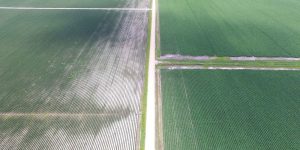A highly-respected farm magazine editor, Greg Horstmeier, has called a spade a spade re the unfolding, dicamba crop-damage train wreck occurring across corn-soybean country.
This is a must-read piece, because of the important historical context it provides. Horstmeier’s play-by-play of how we got here is a chilling account of how badly farm industry leaders and their organizations, agribusiness, and the regulatory community have “managed” herbicide-resistance technology, from the get go.
And it is going to get far worse fast. There is 40 million acres worth of dicamba-resistant soybean seed in the pipeline, nearly one-half of the soybean seed farmers will plant next year. Another chunk of the 2018 national soybean seed supply will be 2,4-D+glyphosate+fop resistant.
Many farmers will buy the dicamba-resistant seeds for protection from drift coming off neighboring fields. Ironically, some of these dicamba-resistant fields will be damaged by 2,4-D drift, and vice versa.
Then the companies will come up with a brilliant idea – three-way resistance in soybeans to glyphosate, 2,4-D, and dicamba (and perhaps glufosinate and the fops too).
And so it will go on, until the seed companies have milked the technology for all its worth, at the expense of farmers who will be left in the lurch with the world’s most daunting complex of multiple-herbicide-resistant weeds and a herbicide toolkit running on empty.

We are watching perhaps one of the most colossal failures of technology adoption and private sector R+D investment decisions in the history of U.S. Ag, Inc. – a failure enabled by farm community and regulatory acquiescence.
While the focus will remain for the foreseeable future on drift and crop damage from the new dicamba- and 2,4-D resistant crops, soon people will start asking questions about the human health implications of the huge increase in herbicide use unfolding across the Heartland.
Both dicamba and 2,4-D are known to raise the risk of a suite of reproductive problems and birth defects, and data is emerging that suggests pregnant women and infants living in heavily sprayed regions may also pay a price as the herbicide treadmill kicks into high gear.
For more on these emerging public-health concerns, follow the work of the project on Herbicide Use and Birth Outcomes in the Midwest.
Source:
Greg Horstmeier, “Editor’s Notebook: Dicamba’s PTFE Problem,” The Progressive Farmer/DTN, August 29, 2017.



The Fraley piece touting the great success of dicamba is so irresponsible. How do these guys sleep at night?
The seed-biotech industry has moved the dicamba-resistant gene into about one-half the soybean seed supply for the 2018 crop season. This ties the hands of regulators, who are not likely to condemn half the soybean seed supply, and so the struggle over this technology will go on. Hopefully farmers and their organizations will become a bit more skeptical going forward the next time the industry touts a new herbicide-resistant technology involving resistance to several herbicides as the solution to the spread of herbicide-resistant weeds created by herbicide-resistant technology. The failure of so many people to grasp these simple connections mystifies me.
Our on farm trials show that a cover crop of cereal rye is very effective at reducing resistant Waterhemp – 90 plus percent. Not to mention the many other benefits of using cover crops.
Dave, killing or setting back cover crops is one of the unintended impacts of rising reliance on herbicides, and especially ones prone to off-target movement. Are you seeing that in your area? I worry that the hopeful trend toward cover crops and enhancing soil health is going to be made more costly and difficult than need be because of all the herbicides moving around ag landscapes. A decade ago, I think the use of sulfonylureas hurt the efforts to establish grass waterways, although there was very little public discussion, and next to no research to document the impacts. A penny for your thoughts.